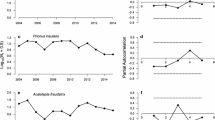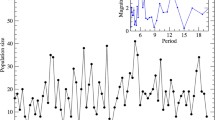Summary
The usefulness of autoregression equations as empirical models of population change in an experimental population of Daphnia magna was studied. A two-term and a ten-term autoregression equation were fit to the data. Tests of the significance of the terms of the ten-term equation were carried out, and the fit of the second-order autoregression tested. The problem of autocorrelated error terms is discussed. The ability of the autoregressions to generate the observed changes in population density of the Daphnia magna population was studied by running Monte Carlo simulations using both the two-term and the ten-term models. Both models were fairly accurate up to a period of about 60 days. The second order autoregression model appeared to be more appropriate at high densities than the ten-term model, but the ten-term model was more effective at population densities less than 80 individuals.
Similar content being viewed by others
References
Aitken, A. C.: On least squares and the linear combination of observations. Proc. roy. Soc. Edinburgh 55, 42–48 (1935).
Durbin, J.: Testing for serial correlation in least-squares regression when some of the regressors are lagged dependant variables. Econometrica 38, 410–421 (1970).
Durbin, J., Watson, G. S.: Testing for serial correlation in least squares regression. II. Biometrika 38, 159–177 (1951).
Hannan, E. J.: Time series analysis, revised edition, 152 pp. London: Methuen and Co. Ltd. 1967.
IBM System/360 Scientific Subroutine Package, Version III, Programmers Mannual. no. GH20-0205-4, 454 pp. (1970).
Kendall, D. G.: Stochastic processes and population growth. J. roy. statist. Soc. B 11, 230–264 (1949).
Malinvaud, E.: Statistical methods of econometrics, 631 pp. Chicago: Rand McNally and Co. 1966.
Mann, H. B., Wald, A.: On the statistical treatment of linear stochastic difference equations. Econometrica 11, 173 (1943).
Moran, P. A. P.: The statistical analysis of sunspot and lynx cycles. J. Animal Ecology 18, 115–116 (1949).
Moran, P. A. P.: The statistical analysis of game-bird records. J. Animal Ecology 21, 154–158 (1952).
Morrison, D. F.: Multivariate statistical methods, 338 pp. New York: McGraw-Hill Book Co. 1967.
Pratt, D. M.: Analysis of population development in Daphnia at different temperatures. Biol. Bull. 85, 116–140 (1943).
Quenouille, M. H.: A large sample test for the goodness of fit of autoregressive schemes. J. roy. statist. Soc. A 110, 123–129 (1947).
Quenouille, M. H.: Approximate tests of correlation in time series. J. roy. statist. Soc. A 112, 68–84 (1949).
Author information
Authors and Affiliations
Rights and permissions
About this article
Cite this article
Poole, R.W. An autoregressive model of population density change in an experimental population of Daphnia magna . Oecologia 10, 205–221 (1972). https://doi.org/10.1007/BF00368964
Received:
Issue Date:
DOI: https://doi.org/10.1007/BF00368964




